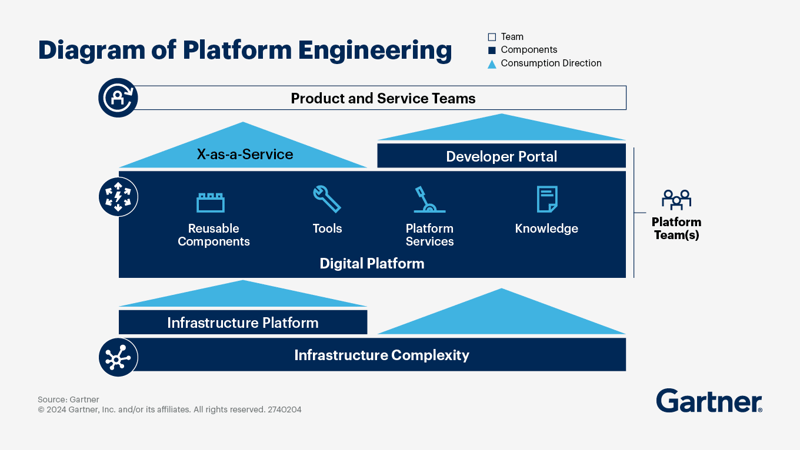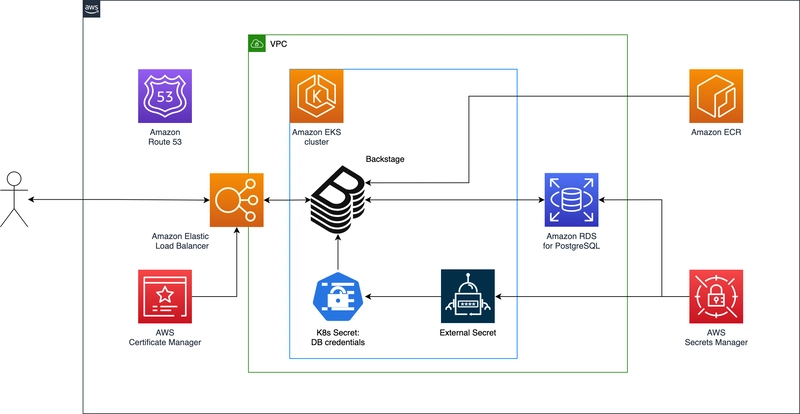Imagine you're working at a fast-growing tech company with multiple development teams. At first, everything runs smoothly—developers write code, deploy it manually, and handle infrastructure as needed. But as the company scales, things get complicated.
Developers struggle to manage different environments. One team runs its services on EC2; another uses Kubernetes, and a third experiments with Lambda. Setting up a new service becomes a hassle, requiring multiple Slack messages, Jira tickets, and DevOps support.
Security updates often take a backseat to feature development—until something breaks.
Instead of focusing on building features, developers spend too much time fixing pipelines and troubleshooting infrastructure.
This chaos slows innovation and creates bottlenecks.
A dedicated Platform Team can solve these issues by building a self-service Internal Developer Platform (IDP). This platform streamlines infrastructure, automates deployments, and enforces best practices, allowing developers to focus on what they do best—writing code.
By 2026, 80% of large software engineering organizations will establish platform engineering teams as internal providers of reusable services, components, and tools for application delivery — up from 45% in 2022. Gartner
What is Platform Engineering?
Platform engineering is creating an Internal Developer Platform (IDP) to facilitate software development and deployment.
Instead of each team handling infrastructure independently, a dedicated platform team builds and manages standard tools, automation, and best practices.
Without a dedicated Platform Team, organizations often encounter:
Lack of Standardization – Development teams may utilize inconsistent tools, CI/CD pipelines, and infrastructure, resulting in inefficiencies.
Increased Cognitive Load on Developers – Engineers have to manage infrastructure, deployments, and security configurations rather than focusing on feature development.
Slow Developer Onboarding – Without an Internal Developer Platform (IDP), new engineers are slower to become productive due to fragmented tools and unclear workflows.
Operational Bottlenecks – SREs and DevOps teams become overwhelmed as developers depend on them for environment provisioning, debugging, and scaling.
Security and Compliance Risks – Without a centralized approach, enforcing security policies, access controls, and compliance becomes more challenging.
Inefficient Incident Management – Debugging production issues takes longer when a unified observability and monitoring framework is absent.
Key Principles of Platform Engineering
Platform engineering is a vital discipline that focuses on designing, creating, and maintaining the underlying systems and infrastructure that support a range of software applications and services. This field encompasses several key principles that guide platform engineers in their work, ensuring scalability, reliability, and efficient resource management:
Platform as a Product – Consider the platform as a dynamic product, gather developer insights, and enhance it continuously.
Developer Experience (DevEx) – Provide self-service tools to minimize friction.
Developer Happiness – Lower cognitive load, eliminate obstacles, and allow engineers to concentrate on innovation.
Faster Feedback Loops – Facilitate rapid iterations and seamless delivery.
Golden Pathways – Establish best software building and deployment practices.
Automation & Observability – Implement Infrastructure-as-Code (IaC), monitoring, and auto-scaling to ensure operational efficiency.
These principles help teams overcome challenges and set long-term goals for a better development workflow.
Now, let’s dive into Platform Engineering with AWS and how it improves the developer experience.
AWS Services for Platform Engineering
AWS offers vast services to create a highly scalable and automated developer platform. This platform enables developers to streamline workflows, enhance productivity, and accelerate application development through various tools and resources.
The key areas include:
Infrastructure as Code (IaC) & Automation: - Use CloudFormation, CDK, or Terraform for infrastructure provisioning. Automate CI/CD workflows with CodePipeline and GitHub Actions. Or use Terraform, an Open-source IaC tool for resource management.
Enable Developer Self-Service: - Provide standardized templates and blueprints. Use the AWS Service Catalog to let teams easily spin up environments. This integration allows for the efficient building, testing, and deployment of applications directly from a GitHub repository to various AWS services, ensuring that code changes are reflected in production with speed and accuracy
CI/CD & DevOps Automation - Integrate GitHub Actions with AWS for seamless deployments.
Containerization & Orchestration - Amazon ECS (Elastic Container Service) provides managed container orchestration, enabling users to easily run and scale containerized applications. Amazon EKS (Elastic Kubernetes Service) offers Kubernetes management on AWS, simplifying the deployment and management of Kubernetes clusters. Additionally, AWS Fargate allows for serverless computing for containers, removing the need for infrastructure management and letting users focus on their applications.
Observability & Monitoring: - Building strong observability from the start is essential, which can be achieved using CloudWatch, X-Ray, and OpenTelemetry for monitoring purposes. Implementing structured logging with centralized storage helps in maintaining comprehensive oversight. Amazon CloudWatch provides a place for logs, metrics, and alarms in one location. AWS X-Ray offers distributed tracing designed explicitly for microservices, while the AWS OpenSearch Service facilitates log analytics and search functionality. Additionally, Prometheus and Grafana on AWS are powerful open-source monitoring tools that can be utilized for enhanced observability.
Security & Governance: - Enforce security from day one by applying IAM least privilege policies and automating security compliance with AWS Config and Security Hub. AWS IAM (Identity and Access Management) is crucial for controlling access and permissions, while AWS Organizations and Control Tower help manage multi-account governance. Additionally, AWS Security Hub provides centralized security insights, and AWS Secrets Manager and Parameter Store ensure secure credential storage.
Optimize for Cost & Performance: - Use AWS Compute Savings Plans & Spot Instances for cost efficiency. Implement auto-scaling to match demand dynamically.
For example, here is how to build Developer Portals with Backstage and Amazon EKS Blueprints - Source AWS
The AWS architecture diagram above illustrates the deployment of Backstage, an open-source developer portal, within an Amazon EKS (Elastic Kubernetes Service) cluster.
Users access Backstage through a domain managed by Amazon Route 53, with traffic routed via an Elastic Load Balancer that secures connections using SSL certificates from AWS Certificate Manager.
The Backstage application runs inside the EKS cluster and relies on Amazon RDS for PostgreSQL as its database.
Sensitive credentials, such as database credentials, are securely stored in AWS Secrets Manager and accessed by the application through an External Secrets mechanism, which syncs them into Kubernetes Secrets.
Backstage retrieves these credentials to connect to the database.
Additionally, container images for Backstage are stored in Amazon ECR, ensuring efficient deployment and scalability.
Overall, this architecture leverages AWS-managed services to provide security, scalability, and ease of management for hosting Backstage in a Kubernetes environment.
It’s crucial to understand how to measure Platform Engineering's success so we can improve it and ensure we're on the right path.
Measuring the Success of Platform Engineering
To measure the effectiveness of Platform Engineering and IDP, organizations should track several key metrics.
For developer productivity, they should consider the lead time for changes (DORA metric), deployment frequency, time to onboard new developers, and the time spent on non-coding tasks, such as setting up environments.
Regarding operational efficiency, organizations should monitor the Mean Time to Recovery (MTTR), the number of support tickets related to CI/CD or environments, and the time spent on infrastructure maintenance.
Developer satisfaction and adoption can be assessed through Developer NPS (Net Promoter Score), self-service adoption rates for deployments, provisioning, and debugging, and feedback from internal surveys.
Additionally, quality and stability metrics include the number of failed deployments, incident resolution time, and improvements in test coverage.
Finally, for security and compliance, organizations should track the number of security vulnerabilities identified and remediated, along with compliance adherence rates.
Final Thoughts
Platform Engineering with AWS empowers teams to construct scalable, self-service, and developer-friendly environments tailored to their unique needs.
By effectively leveraging a suite of AWS services—including Amazon Elastic Kubernetes Service (EKS), Amazon Elastic Container Service (ECS), AWS Lambda, Terraform for infrastructure as code, AWS CodePipeline for continuous integration and delivery, Amazon CloudWatch for monitoring, and AWS Identity and Access Management (IAM) for security management—teams can significantly enhance their operational efficiency.
This strategic use of AWS tools increases developer productivity by streamlining workflows and automating processes, ultimately allowing developers to focus on innovation rather than maintenance.
Additionally, these capabilities reduce operational headaches, facilitating smoother project execution and faster time-to-market for applications.
In essence, Platform Engineering with AWS fosters a modern development environment and creates a robust foundation for future growth and scalability within organizations.
Helpful Resources:
Building Developer Portals with Backstage and Amazon EKS Blueprints
AWS re:Invent 2023 - Platform engineering with Amazon EKS (CON311)
Thank you for reading




Top comments (0)